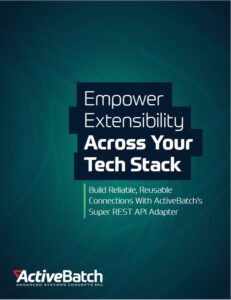Best Practices For Hybrid IT Workload Optimization

Most IT environments depend on a mix of on-premises and cloud-based resources. Digital business goals require scalability and flexibility and will continue to push the need for cloud migrations. At the same time, new technologies (IoT, natural language processing, microservices) and best-of-breed requirements are driving an increase in multicloud environments.
- Over 90% of enterprises will have a mix of on-premises and private/public cloud platforms by 2022
- 90% of enterprises expect to increase cloud usage due to the COVID-19 pandemic
- 63% of CIOs believe their cloud environments have “surpassed human ability to manage”
- 69% of CIOs believe they need a “radically different approach” to cloud operations
As more workloads are deployed in multi- and hybrid-cloud environments, IT teams will need to unify disparate resources and applications across the tech stack in order to provide reliable services. Workload optimization practices will be key to this effort by supporting:
- Faster services for improved customer experience
- Real-time data for accurate information and analytics
- Scalable infrastructure to meet dynamic cloud demands
- More reliable processes and connections between disparate endpoints
Workload optimization can improve reliability by reducing the need for troubleshooting and human interventions. Processes can be streamlined to minimize risks and improve application performance. These benefits in turn make it easier to scale services and environments, enabling IT to digitize more processes and handle more workloads for business needs.
6 Methods For Achieving Optimal Workload Performance
Implement An Extensible Solution
Extensible solutions such as workload automation platforms can be used to connect disparate endpoints across the enterprise, regardless of technology or operating system (AWS, Linux, Microsoft Azure, etc). Through programmatic integrations including API adapters, IT teams can unify control over workloads, resources and applications. This can drastically reduce complexity by enabling optimization opportunities across environments.
Stay ahead of business needs with reliable, reusable integrations
See how API adapters enable developers of any skill level to build connections for end-to-end processes and IT services.
Automate As Much As Possible
Manual interactions increase the risk of failures and delays while increasing the time it takes to complete processes. Automating those manual tasks is critical to managing expanding environments that are complex and dynamic.
Traditional workload automation methods such as date/time scheduling will continue to be important but are unable to support dynamic processes and real-time data. This requires event-based automation. Using triggers, IT teams can have automated processes execute based on business or IT events (file and email events, completion of predecessor jobs, system startups and more).
Hybrid and multi-cloud environments are too complex to manually manage, especially when IT teams are overworked and short-staffed. Automating IT operations and infrastructure processes enable teams to achieve more with fewer resources, dedicating more of those resources to development while providing more reliability and efficiency.
Simplify Development
IT environments are going to grow and evolve as businesses face new challenges. This includes new endpoints and services for which developers will have to create new workloads and processes. Providing developers with the right tools can streamline the development process so developers can spend more time optimizing.
Workload automation software can provide a variety of features for developers. Tools that map interdependencies and relationships between processes should be used to identify bottlenecks, delays and where workloads can be run in parallel, for instance.
Additionally, extensible automation solutions can provide universal connectors and reusable templates that enable users to simplify complex, cross-platform processes. This reduces the volume of workloads that need to be executed, freeing-up resources while reducing the risk of failures.
Improve Visibility And Monitoring
IT environments are often fragmented with environments designed around disparate technologies. 89% of IT leaders reported that silos in IT are an obstacle to their digital transformation goals, MuleSoft found. This has implications for monitoring and viewing. A study by DynaTrace found that enterprises use an average of 10 monitoring solutions across tech silos.
Monitoring end-to-end processes is critical to building reliable services and making IT environments manageable. The more time IT spends fighting fires, the less time IT spends developing solutions.
Implementing run-time monitoring across environments helps keep IT up-to-date. In the case of failure, a monitoring solution can be used to immediately notify the appropriate IT team members, reducing time-to-resolution and minimizing impacts on business.
Additionally, run-time monitoring can be used to improve the reliability of processes. If a system notices a delayed workload, additional resources can be allocated to complete the workload on time, or the system can automatically pause the workload to wait for a constraint to be met.
Run-time monitoring improves workload reliability and can drastically reduce delays caused by bottlenecks, especially for SLA-critical workloads. Perhaps most importantly, run-time monitoring and event automation can be used to set up auto-remediation workflows.
Centralizing your monitoring across environments also improves visibility. Centralized log repositories make it easier for IT operations to troubleshoot issues while in-depth reporting makes it easier to identify optimization opportunities.
Manage Infrastructure With Intelligent Analytics
The goal for optimizing workloads is to make sure data is delivered efficiently and reliably to support services for end-users. By orchestrating end-to-end processes that connect infrastructure to the service layer, IT teams can streamline the delivery of data.
Workload automation (WLA) tools can be used to manage application resources and optimize workload placement. WLA tools provide scheduling algorithms that balance server loads to help prevent bottlenecks and delayed workloads. Resources can be reserved for critical SLA workloads based on CPU, memory and other parameters required by the workload.
Additionally, machine learning (ML) algorithms can be applied to historical data in order to plan and manage infrastructure for future demand. For example, if end-of-week reports are run each Friday, the WLA solution will ensure that optimal resources are available prior to run-time.
ML should also be applied to real-time provisioning in order to ensure that your environment can rapidly respond to spikes in demand. WLA tools with ML will spin-up and spin-down cloud-based resources and virtual machines (VMs) based on real-time compute needs, removing human intervention and preventing server sprawl.
Monitor And Optimize The Environment
Extensible workload automation solutions make it possible to connect to any cloud service in your enterprise, enabling hybrid IT automation. Users can monitor workloads, servers and applications, regardless of the underlying technology, from a single platform.
Workload automation environments are critical to IT and business operations. Time and energy are spent optimizing workloads and processes, and should be spent on optimizing data center environments as well.
As artificial intelligence and machine learning advance, these technologies are being used to analyze WLA environments, gathering historical data and monitoring those environments in real time. This gives IT operations powerful new capabilities to identify optimization opportunities, making the environment more reliable and efficient while preventing future issues.
Ready to simplify your data warehousing with workload automation?
Schedule a demo to watch our experts run jobs that match your business requirements in ActiveBatch. Get your questions answered and learn how easy it is to build and maintain your jobs.








